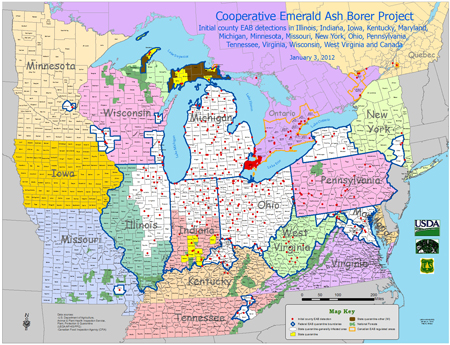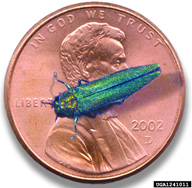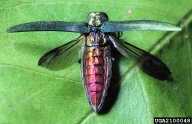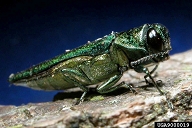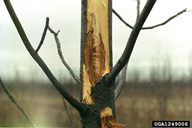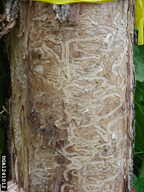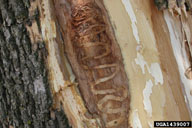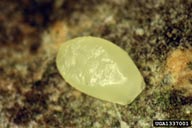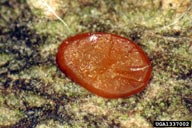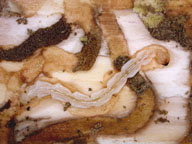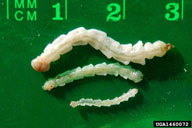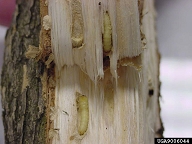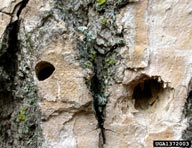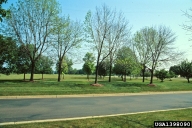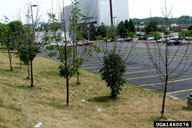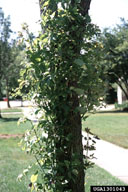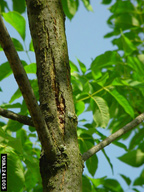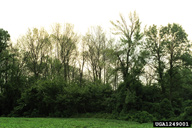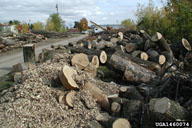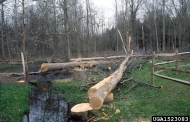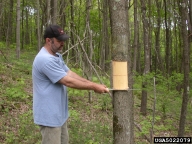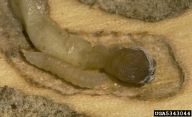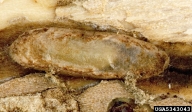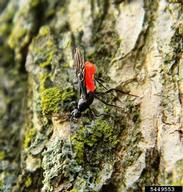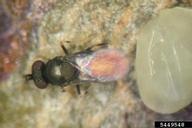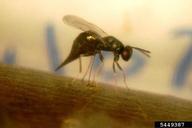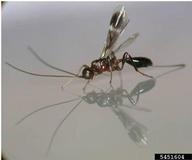Emerald ash borer
Agrilus planipennis Fairmaire (Coleoptera: Buprestidae)
Orientation to pest
Emerald ash borer, Agrilus planipennis Fairmaire, is an invasive borer from northeast Asia threatening North American ash trees (Fraxinus). It was first detected near Detroit, Michigan and likely was introduced in the 1990s. It is now found in 14 other states and two Canadian provinces, and the infested range is expanding rapidly. Emerald ash borer attacks and kills healthy ash trees from ones several inches in diameter to mature trees. Massive mortality to ash of several species has occurred since the species' invasion in both landscape plantings and natural ash-dominated communities, especially in riparian areas. Larvae feed on phloem and make serpentine galleries that girdle and kill trees when the larval densities are high. Mature larvae tunnel into sap wood to pupate. In northern areas (e.g., Michigan), a single generation may require two years, but in mid-Atlantic states (e.g., Maryland), a generation can be completed each year. In dense populations, woodpeckers consume many larvae.
Hosts commonly attacked
Most North American Fraxinus species are susceptible, but so far the most affected species have been white (Fraxinus americana L.), green (Fraxinus pennsylvanica Marshall), and black (Fraxinus nigra Marshall) ash.
Distribution
The North America infested area is centered on Michigan. Extensive infestations exist in Ontario, Illinois, Indiana, Ohio, Kentucky, Pennsylvania, and Maryland, and smaller infested areas are found in Quebec, Minnesota, Iowa, Wisconsin, Missouri, Tennessee, New York, Virginia, and West Virginia (as of 2010).
| Figure 1. Distribution of emerald ash borer in 2010 |
Images of emerald ash borer
| Figure 2. Adults of emerald ash borer, Agrilus planipennis | |
| Figure 3. Emerald ash borer eggs are white (left) when freshly laid, but turn tan as they age (right) | |
| Figure 4. Feeding stage larvae of emerald ash borer: left - full grown 4th instar; right - second, third and 4th instars | Figure 5. Larval galleries of emerald ash borer. |
| Figure 6. Prepupae in chambers formed in sap wood by mature larvae | Figure 7. Prepupa of emerald ash borer in chamber in sap wood | Figure 8. "D"-shaped emergence hole of emerald ash borer (left) and hole made by woodpecker (right) where an emerald ash borer larva was removed | |
| Figure 9. Signs of infestation: left, suckering: right, bark splits | Figure 10. Dead and dying ash in forest area due to emerald ash borer | Figure 11. Dying or dead landscape trees affected by emerald ash borer | |
| Figure 12. Tree removal was tried, unsuccessfully, as a means to eradicate emerald ash borer populations. | Figure 13. Girdling trees can be an effective survey method to detect emerald ash borers | ||
| Figure 14. The Chinese parasitoid of emerald ash borer eggs, Oobius agrili | Figure 15. The Chinese larval parasitoid Tetrastichus planipennisi | Figure 16. The Chinese emerald ash borer larval parasitoid, Spathius agrili | Figure 17. Larva, pupa (in cocoon), and adult of the native North American parasitoid Atanycolus cappaerti Marsh and Strazanac |
Important biological control agents related to this pest species
Natural enemies of emerald ash borer that have been collected in the native range (especially in China and Russia) include two larval parasitoids (the eulophid Tetrastichus planipennisi Yang and the braconid Spathius agrili Yang), and an egg parasitoid, Oobius agrili Zhang and Huang (Hymenoptera: Encyrtidae). Additional parasitoids have been identified and are under consideration for importation, including Spathius n. sp. and Antanycolus picipes Telenga from Russia. One group of native North American parasitoids, braconids in the genus Atanycolus, has adopted emerald ash borer and causes up to 20-40% mortality of the larvae in some areas.
Web links for information on emerald ash borer
- Target Pest Listing | University of Massachusetts Amherst
From "Biological Control of Pests in Forests of Eastern United States" website - Emerald Ash Borer Research | Northern Research Station, USDA Forest Service
Research and findings on risk, detection, and spread, biology and ecology, control and management, and effects and impacts - Invasive Insects Fact Sheet |
New York Department of Environmental Conservation
Articles
- Liu, H-P, L. S. Bauer, D. L. Miller, L-W. Song, Q-S. Luan, S-H. Sun, and R.Z. Jin. 2007 Seasonal abundance and population dynamics of Agrilus planipennis (Coleoptera: Buprestidae) and its natural enemies Oobius agrili (Hymenoptera: Encyrtidae) and Tetrastichus planipennisi (Hymenoptera: Eulophidae) in China. Biological Control 42: 61-71.
- Yang, Z-Q, J. S. Strazanac, P. M. Marsh, C. van Achterberg, and W-Y. Choi. 2005. First recorded parasitoid from China of Agrilus planipennis: A new species of Spathius (Hymenoptera: Braconidae, Doryctinae). Annals of the Entomological Society of America 98: 636-642.
- Yang, Z-Q., J. S. Strazanac, Y-X. Yao, and X-Y. Wang. 2006. A new species of emerald ash borer parasitoid from China belonging to the genus Tetrastichus Haliday (Hymenoptera: Eulophidae) parasitizing emerald ash borer from China. Proceedings of the Entomological Society of Washington 108: 550-558.
- Zhang,Y. Z., D.W. Huang, T. H. Zhao, H. P. Liu, and L. S. Bauer. 2005. Two new species of egg parasitoids (Hymenoptera: Encrytidae) of wood-boring beetle pests from China. Phytoparasitica 33: 253-260.
- Duan, J.J., L.S Bauer, J.R. Gould, and J.P. Lelito. 2011. Biological control of emerald ash borer in North America: Current progress and potential for success. IOBC Newsletter, November 2011.
- Duan, J. J., L. S Bauer, K. J. Abell, and R. G. Van Driesche. 2011. Population responses of hymenopteran parasitoids to the emerald ash borer (Coleoptera: Buprestidae) in north central United States. BioControl (in press)
